Economics for Managers: Australian Economic Policy and Fiscal Analysis
VerifiedAdded on 2020/05/04
|7
|903
|35
Homework Assignment
AI Summary
This economics assignment analyzes various economic policies, focusing on the Australian context. The paper examines the impact of taxation and subsidies on food and beverages, the role of fiscal stimulus in reviving the economy during a recession, and the effects of government spending on aggregate demand. It also explores the relationship between fiscal and monetary policy, including the use of expansionary and contractionary measures, and their influence on investment, interest rates, and exchange rates. The assignment further discusses the effectiveness of monetary policy versus fiscal stimulus in Australia, considering the country's strong financial sector and foreign borrowing. The solution references relevant sources and provides diagrams to illustrate key concepts.
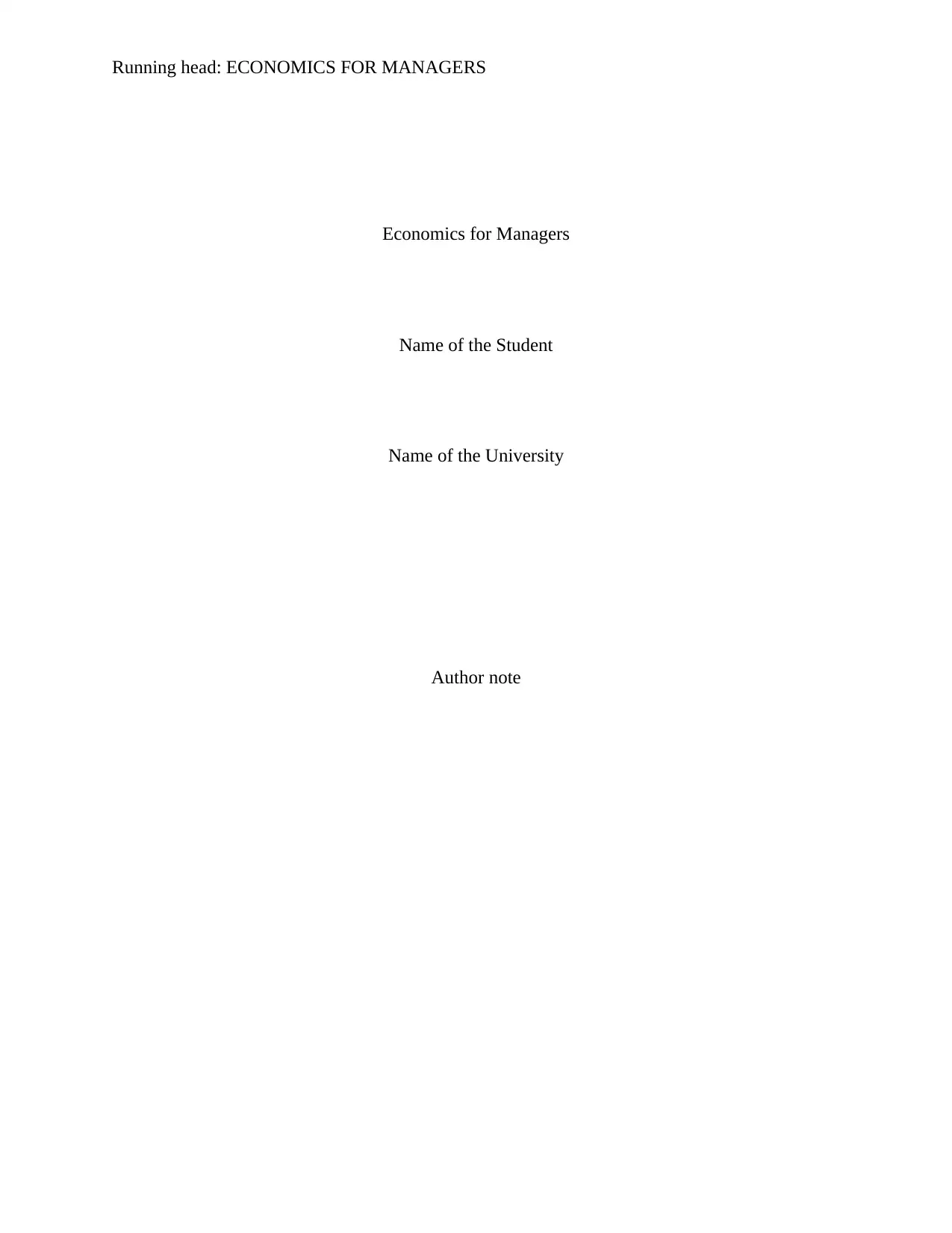
Running head: ECONOMICS FOR MANAGERS
Economics for Managers
Name of the Student
Name of the University
Author note
Economics for Managers
Name of the Student
Name of the University
Author note
Paraphrase This Document
Need a fresh take? Get an instant paraphrase of this document with our AI Paraphraser
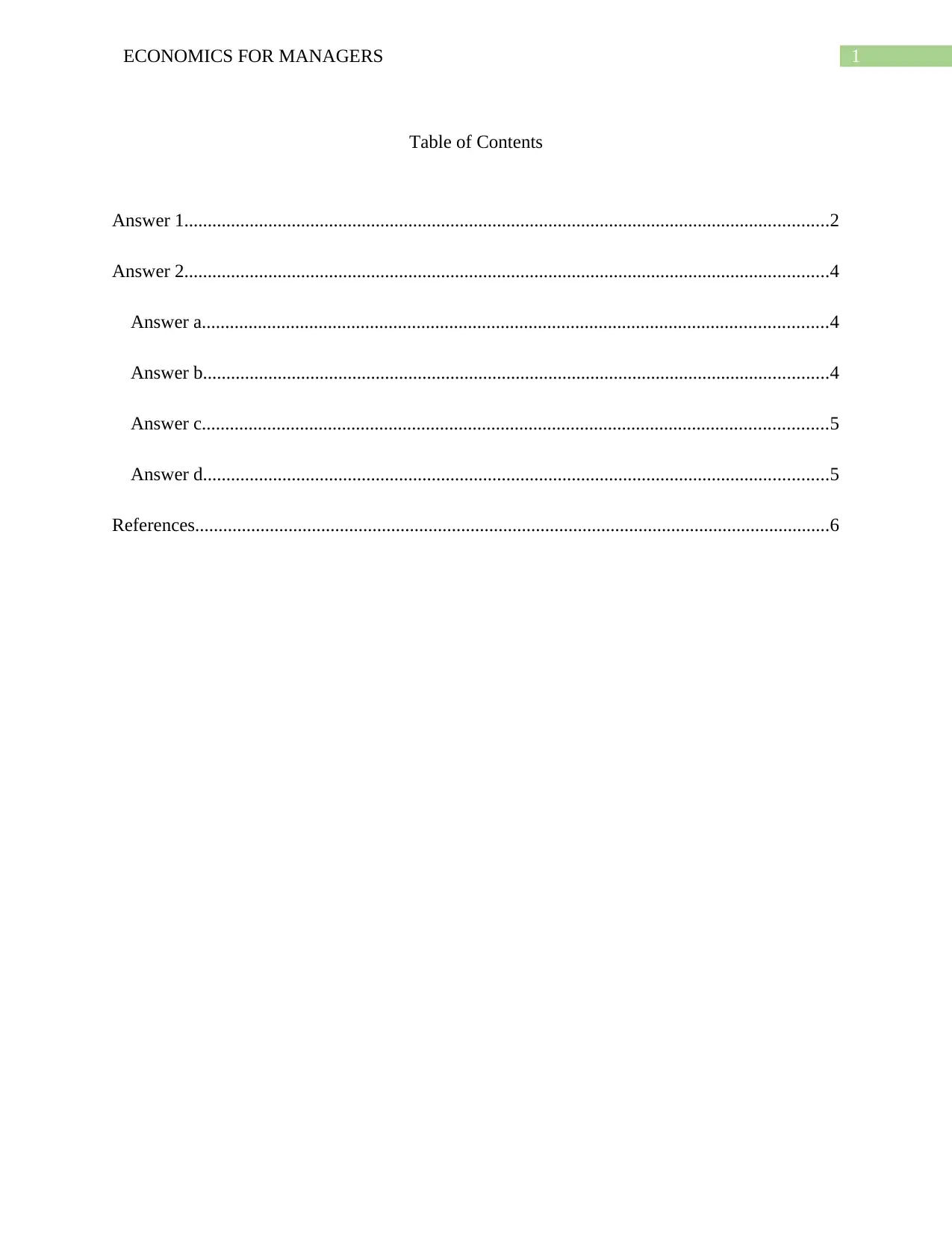
1ECONOMICS FOR MANAGERS
Table of Contents
Answer 1..........................................................................................................................................2
Answer 2..........................................................................................................................................4
Answer a......................................................................................................................................4
Answer b......................................................................................................................................4
Answer c......................................................................................................................................5
Answer d......................................................................................................................................5
References........................................................................................................................................6
Table of Contents
Answer 1..........................................................................................................................................2
Answer 2..........................................................................................................................................4
Answer a......................................................................................................................................4
Answer b......................................................................................................................................4
Answer c......................................................................................................................................5
Answer d......................................................................................................................................5
References........................................................................................................................................6
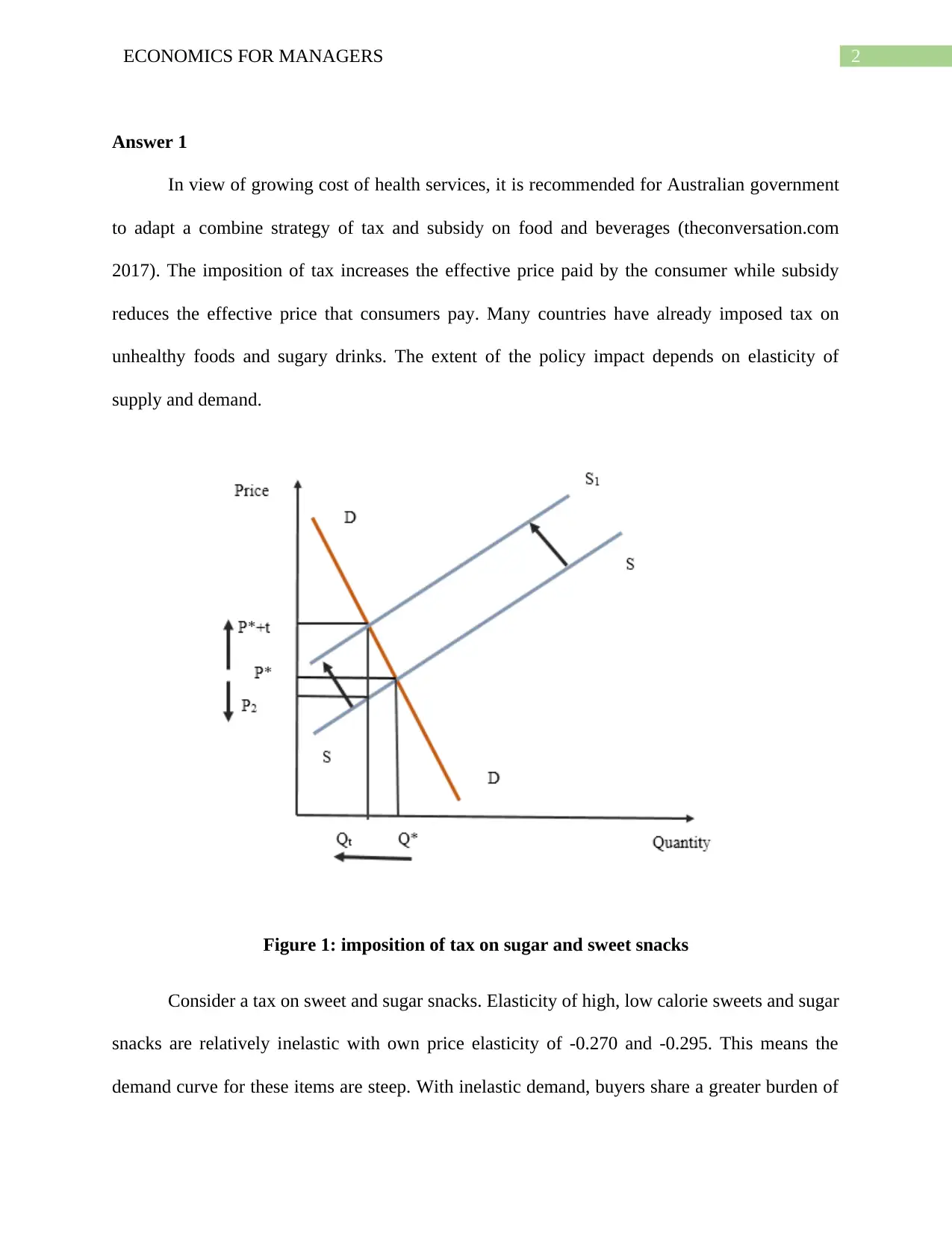
2ECONOMICS FOR MANAGERS
Answer 1
In view of growing cost of health services, it is recommended for Australian government
to adapt a combine strategy of tax and subsidy on food and beverages (theconversation.com
2017). The imposition of tax increases the effective price paid by the consumer while subsidy
reduces the effective price that consumers pay. Many countries have already imposed tax on
unhealthy foods and sugary drinks. The extent of the policy impact depends on elasticity of
supply and demand.
Figure 1: imposition of tax on sugar and sweet snacks
Consider a tax on sweet and sugar snacks. Elasticity of high, low calorie sweets and sugar
snacks are relatively inelastic with own price elasticity of -0.270 and -0.295. This means the
demand curve for these items are steep. With inelastic demand, buyers share a greater burden of
Answer 1
In view of growing cost of health services, it is recommended for Australian government
to adapt a combine strategy of tax and subsidy on food and beverages (theconversation.com
2017). The imposition of tax increases the effective price paid by the consumer while subsidy
reduces the effective price that consumers pay. Many countries have already imposed tax on
unhealthy foods and sugary drinks. The extent of the policy impact depends on elasticity of
supply and demand.
Figure 1: imposition of tax on sugar and sweet snacks
Consider a tax on sweet and sugar snacks. Elasticity of high, low calorie sweets and sugar
snacks are relatively inelastic with own price elasticity of -0.270 and -0.295. This means the
demand curve for these items are steep. With inelastic demand, buyers share a greater burden of
⊘ This is a preview!⊘
Do you want full access?
Subscribe today to unlock all pages.

Trusted by 1+ million students worldwide
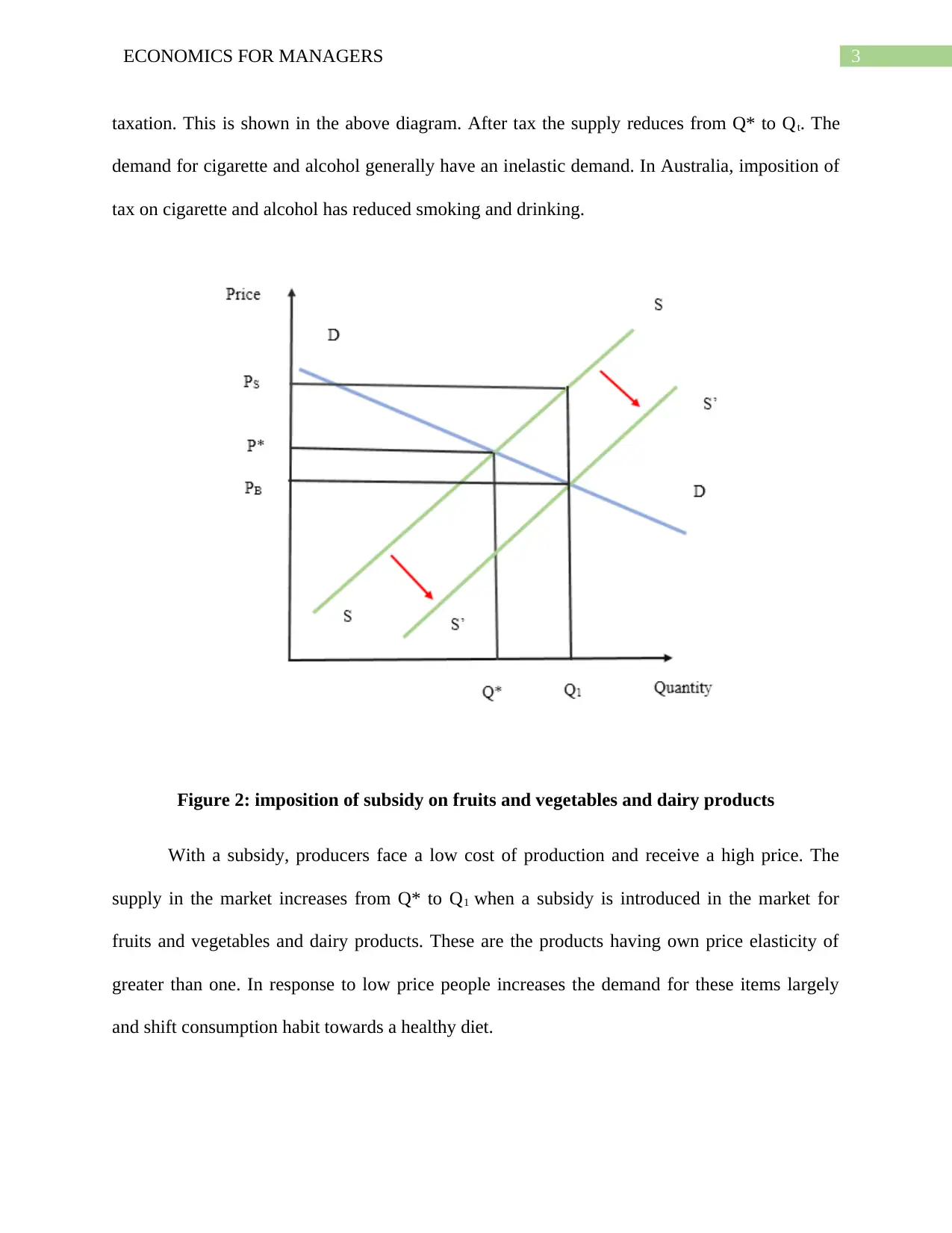
3ECONOMICS FOR MANAGERS
taxation. This is shown in the above diagram. After tax the supply reduces from Q* to Qt. The
demand for cigarette and alcohol generally have an inelastic demand. In Australia, imposition of
tax on cigarette and alcohol has reduced smoking and drinking.
Figure 2: imposition of subsidy on fruits and vegetables and dairy products
With a subsidy, producers face a low cost of production and receive a high price. The
supply in the market increases from Q* to Q1 when a subsidy is introduced in the market for
fruits and vegetables and dairy products. These are the products having own price elasticity of
greater than one. In response to low price people increases the demand for these items largely
and shift consumption habit towards a healthy diet.
taxation. This is shown in the above diagram. After tax the supply reduces from Q* to Qt. The
demand for cigarette and alcohol generally have an inelastic demand. In Australia, imposition of
tax on cigarette and alcohol has reduced smoking and drinking.
Figure 2: imposition of subsidy on fruits and vegetables and dairy products
With a subsidy, producers face a low cost of production and receive a high price. The
supply in the market increases from Q* to Q1 when a subsidy is introduced in the market for
fruits and vegetables and dairy products. These are the products having own price elasticity of
greater than one. In response to low price people increases the demand for these items largely
and shift consumption habit towards a healthy diet.
Paraphrase This Document
Need a fresh take? Get an instant paraphrase of this document with our AI Paraphraser
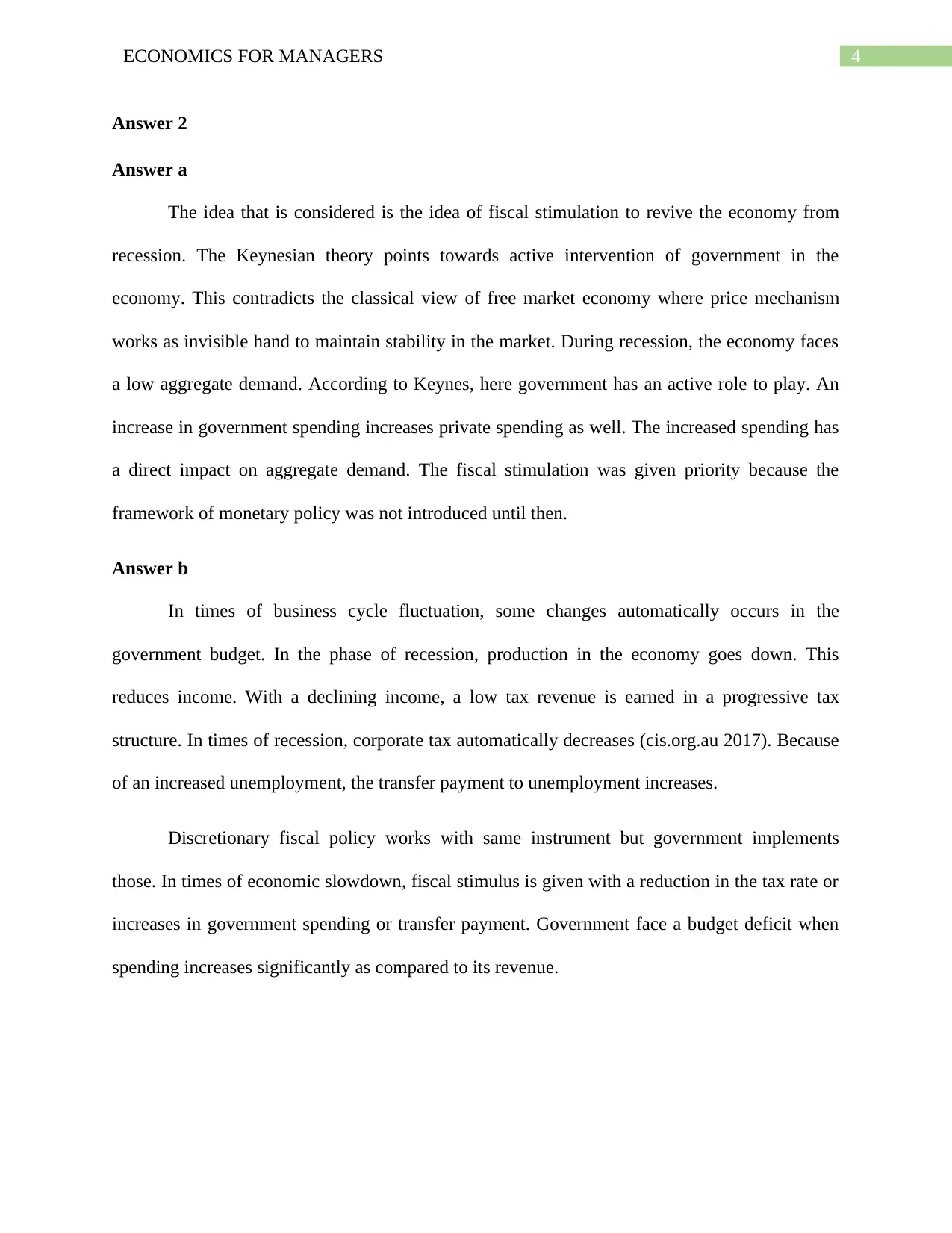
4ECONOMICS FOR MANAGERS
Answer 2
Answer a
The idea that is considered is the idea of fiscal stimulation to revive the economy from
recession. The Keynesian theory points towards active intervention of government in the
economy. This contradicts the classical view of free market economy where price mechanism
works as invisible hand to maintain stability in the market. During recession, the economy faces
a low aggregate demand. According to Keynes, here government has an active role to play. An
increase in government spending increases private spending as well. The increased spending has
a direct impact on aggregate demand. The fiscal stimulation was given priority because the
framework of monetary policy was not introduced until then.
Answer b
In times of business cycle fluctuation, some changes automatically occurs in the
government budget. In the phase of recession, production in the economy goes down. This
reduces income. With a declining income, a low tax revenue is earned in a progressive tax
structure. In times of recession, corporate tax automatically decreases (cis.org.au 2017). Because
of an increased unemployment, the transfer payment to unemployment increases.
Discretionary fiscal policy works with same instrument but government implements
those. In times of economic slowdown, fiscal stimulus is given with a reduction in the tax rate or
increases in government spending or transfer payment. Government face a budget deficit when
spending increases significantly as compared to its revenue.
Answer 2
Answer a
The idea that is considered is the idea of fiscal stimulation to revive the economy from
recession. The Keynesian theory points towards active intervention of government in the
economy. This contradicts the classical view of free market economy where price mechanism
works as invisible hand to maintain stability in the market. During recession, the economy faces
a low aggregate demand. According to Keynes, here government has an active role to play. An
increase in government spending increases private spending as well. The increased spending has
a direct impact on aggregate demand. The fiscal stimulation was given priority because the
framework of monetary policy was not introduced until then.
Answer b
In times of business cycle fluctuation, some changes automatically occurs in the
government budget. In the phase of recession, production in the economy goes down. This
reduces income. With a declining income, a low tax revenue is earned in a progressive tax
structure. In times of recession, corporate tax automatically decreases (cis.org.au 2017). Because
of an increased unemployment, the transfer payment to unemployment increases.
Discretionary fiscal policy works with same instrument but government implements
those. In times of economic slowdown, fiscal stimulus is given with a reduction in the tax rate or
increases in government spending or transfer payment. Government face a budget deficit when
spending increases significantly as compared to its revenue.
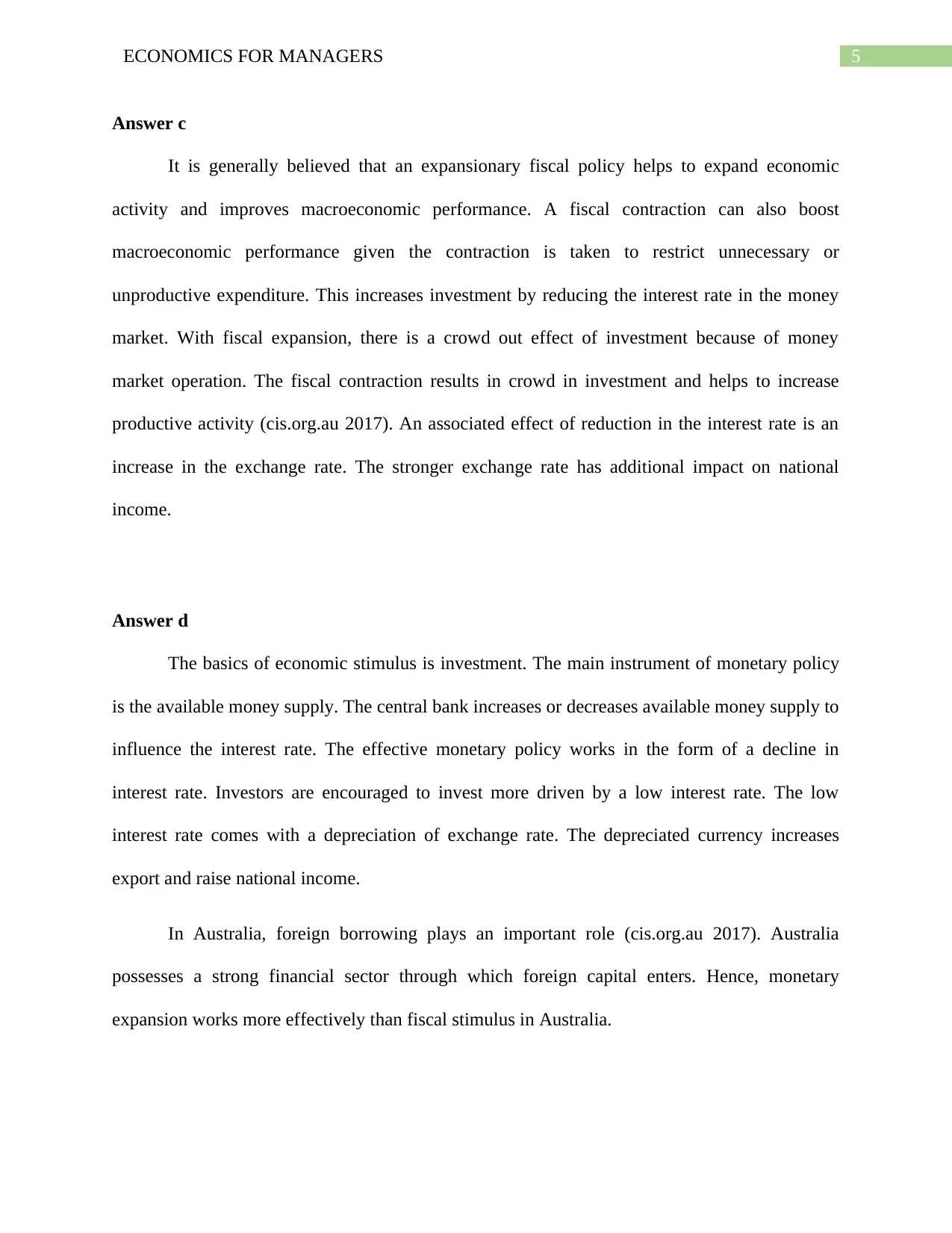
5ECONOMICS FOR MANAGERS
Answer c
It is generally believed that an expansionary fiscal policy helps to expand economic
activity and improves macroeconomic performance. A fiscal contraction can also boost
macroeconomic performance given the contraction is taken to restrict unnecessary or
unproductive expenditure. This increases investment by reducing the interest rate in the money
market. With fiscal expansion, there is a crowd out effect of investment because of money
market operation. The fiscal contraction results in crowd in investment and helps to increase
productive activity (cis.org.au 2017). An associated effect of reduction in the interest rate is an
increase in the exchange rate. The stronger exchange rate has additional impact on national
income.
Answer d
The basics of economic stimulus is investment. The main instrument of monetary policy
is the available money supply. The central bank increases or decreases available money supply to
influence the interest rate. The effective monetary policy works in the form of a decline in
interest rate. Investors are encouraged to invest more driven by a low interest rate. The low
interest rate comes with a depreciation of exchange rate. The depreciated currency increases
export and raise national income.
In Australia, foreign borrowing plays an important role (cis.org.au 2017). Australia
possesses a strong financial sector through which foreign capital enters. Hence, monetary
expansion works more effectively than fiscal stimulus in Australia.
Answer c
It is generally believed that an expansionary fiscal policy helps to expand economic
activity and improves macroeconomic performance. A fiscal contraction can also boost
macroeconomic performance given the contraction is taken to restrict unnecessary or
unproductive expenditure. This increases investment by reducing the interest rate in the money
market. With fiscal expansion, there is a crowd out effect of investment because of money
market operation. The fiscal contraction results in crowd in investment and helps to increase
productive activity (cis.org.au 2017). An associated effect of reduction in the interest rate is an
increase in the exchange rate. The stronger exchange rate has additional impact on national
income.
Answer d
The basics of economic stimulus is investment. The main instrument of monetary policy
is the available money supply. The central bank increases or decreases available money supply to
influence the interest rate. The effective monetary policy works in the form of a decline in
interest rate. Investors are encouraged to invest more driven by a low interest rate. The low
interest rate comes with a depreciation of exchange rate. The depreciated currency increases
export and raise national income.
In Australia, foreign borrowing plays an important role (cis.org.au 2017). Australia
possesses a strong financial sector through which foreign capital enters. Hence, monetary
expansion works more effectively than fiscal stimulus in Australia.
⊘ This is a preview!⊘
Do you want full access?
Subscribe today to unlock all pages.

Trusted by 1+ million students worldwide
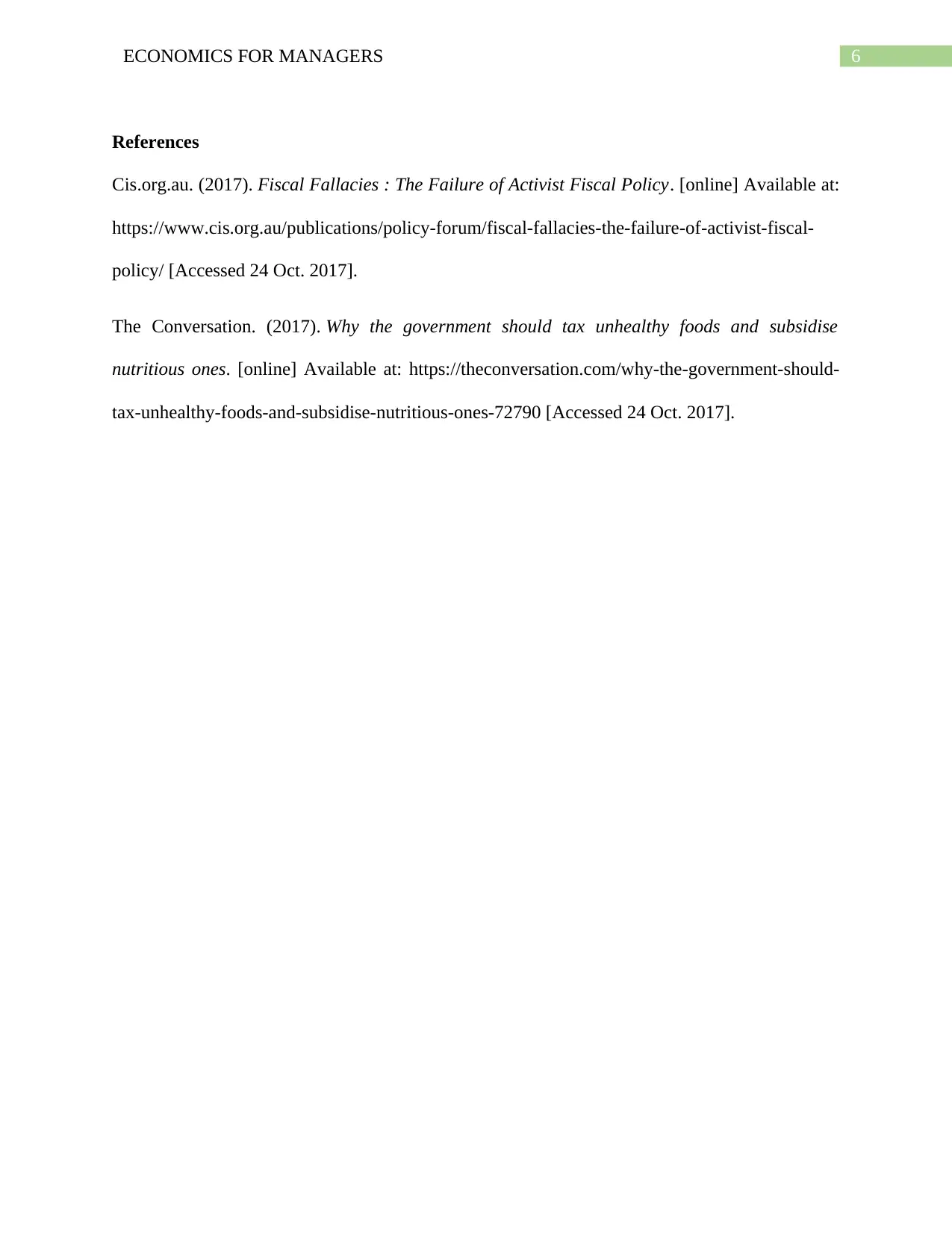
6ECONOMICS FOR MANAGERS
References
Cis.org.au. (2017). Fiscal Fallacies : The Failure of Activist Fiscal Policy. [online] Available at:
https://www.cis.org.au/publications/policy-forum/fiscal-fallacies-the-failure-of-activist-fiscal-
policy/ [Accessed 24 Oct. 2017].
The Conversation. (2017). Why the government should tax unhealthy foods and subsidise
nutritious ones. [online] Available at: https://theconversation.com/why-the-government-should-
tax-unhealthy-foods-and-subsidise-nutritious-ones-72790 [Accessed 24 Oct. 2017].
References
Cis.org.au. (2017). Fiscal Fallacies : The Failure of Activist Fiscal Policy. [online] Available at:
https://www.cis.org.au/publications/policy-forum/fiscal-fallacies-the-failure-of-activist-fiscal-
policy/ [Accessed 24 Oct. 2017].
The Conversation. (2017). Why the government should tax unhealthy foods and subsidise
nutritious ones. [online] Available at: https://theconversation.com/why-the-government-should-
tax-unhealthy-foods-and-subsidise-nutritious-ones-72790 [Accessed 24 Oct. 2017].
1 out of 7
Related Documents
Your All-in-One AI-Powered Toolkit for Academic Success.
+13062052269
info@desklib.com
Available 24*7 on WhatsApp / Email
![[object Object]](/_next/static/media/star-bottom.7253800d.svg)
Unlock your academic potential
Copyright © 2020–2025 A2Z Services. All Rights Reserved. Developed and managed by ZUCOL.





